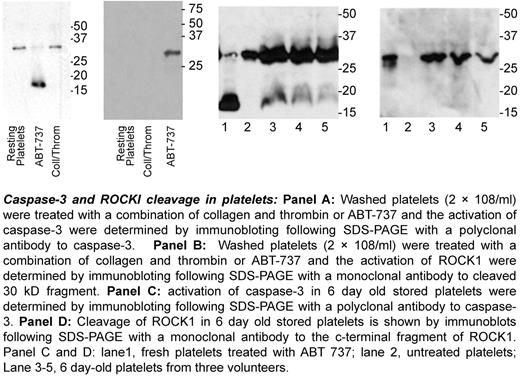Abstract
Abstract 2117
Poster Board II-94
The transbilayer movement of phosphatidylserine from the inner to the outer leaflet of membrane bilayer occurs during platelet activation and is essential for platelet procoagulant activity. Expression of phosphatidylserine also occurs in platelets stored more than 5 days in the blood bank. We have examined the role of mitochondrial pathways in activation-induced platelet procoagulant activity and during in vitro senescence. Collagen and thrombin-induced exposure of phosphatidylserine is associated with a decrease in mitochondrial membrane potential (MMP). Cyclosporin A, a known inhibitor of cyclophilin D, inhibited phosphatidylserine exposure and the loss of MMP. Consistent with this, platelets from CypD deficient mice had decreased loss of MMP and impaired phosphatidylserine exposure when treated with a combination of thrombin and collagen. However, there is no release of cytochrome c into the cytosol. Also there is no activation of caspase-3 or Rho associated kinase I (ROCK1). In sharp contrast to this, in platelets stored for more than 5 days, phosphatidylserine exposure is found to be associated with caspase-3 and ROCK1 activation. To delineate the mechanism we used ABT737, a BH3 mimetic that induces mitochondrial pathway of apoptosis via Bcl-2 family of proteins. ABT737-induced phosphatidylserine exposure was also associated with cytochrome c release, caspase-3 and ROCKI activation and it is unaffected in platelets isolated from CypD knock out mice or in platelets treated with cyclosporine A prior to activation. Caspase-3 inhibitor (z-DVED-fmk and ROCK1 inhibitor Y-27632 reduced ABT-737 induced phosphatidylserine expression.
Our results also show that activation-induced phosphatidylserine exposure is dependent on mitochondrial membrane depolarization and CypD but is independent of cytochrome c release or caspase-3 or ROCK1 activation. In contrast, the phosphatidylserine exposure in stored platelets occurs via mitochondrial cytochrome c release, caspase-3 activation and ROCKI activation and does not depend on mitochondrial membrane depolarization or CypD.
No relevant conflicts of interest to declare.
Author notes
Asterisk with author names denotes non-ASH members.


